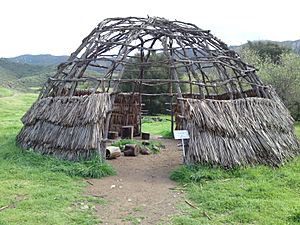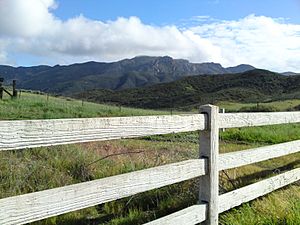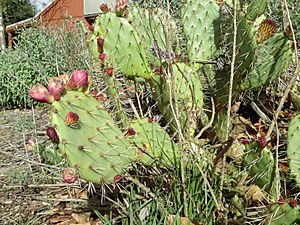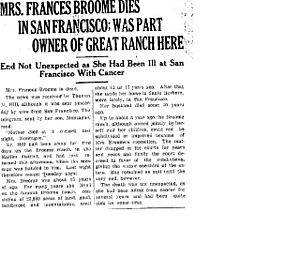Rancho Guadalasca facts for kids
Rancho Guadalasca was a very large piece of land, about 30,594 acres (which is about 124 square kilometers), located in what is now Ventura County, California. In 1836, during the time California was part of Mexico, the governor gave this land as a grant to a woman named Ysabel Yorba.
This rancho was in the southern part of Ventura County, close to Los Angeles County. It stretched along the Pacific coast near Point Mugu for about eight miles. It also went inland along Guadalasca Creek in the Santa Monica Mountains for about ten miles. This area has a rich history, being the site of an ancient village called Xucu, known as "The Town of the Canoes." It was once one of the most populated parts of the coast. One valley, La Jolla, was a favorite spot for Native Americans, full of old tools and bones.

Contents
Ancient Life on Rancho Guadalasca
Long before Rancho Guadalasca became a land grant, it was home to the Chumash people. They lived, raised families, and built communities here for over 9,000 years. The Chumash often lived in small camps that they moved with the seasons.
One important Chumash village on this land was called Satwiwa, which means "bluff." The shape of the land here made it a major trade route for the Chumash. The rancho's wide canyon allowed easy access to Satwiwa village for trading. Trade was a very important part of Chumash society. They used special beads and shells from the Channel Islands as money to trade with other villages.
Another important tool for Chumash trade was the "Tomol," a type of canoe used for ocean travel. Different areas offered unique items for trade. For example, coastal villages traded seafood and shells with inland villages for game and obsidian. They used the trade route that went through the rancho. Rancho Guadalasca has been a key place for trade and community for thousands of years.
From Missions to Ranchos
For a long time, Native American groups lived with little contact from Europeans. This changed when Spanish missions were built in California between 1769 and 1823. These missions were placed about a day's horse ride apart along the main road, the Camino Real. The Spanish explored and claimed more land.
Native Americans were slowly brought into the Mission system. They were moved from their villages and islands to live at the missions. During this time, new diseases were introduced, which sadly caused many Native Americans to die.
After the Mission system declined, during the Mexican period, large land grants were given out. Many of these grants went to army veterans. These early land grants became known as "ranchos," and they included Rancho Guadalasca. Rancho Guadalasca, covering about 30,594 acres, was empty and not farmed until Ysabel Yorba asked to own it in 1836.
The name Guadalasca likely comes from shuwalaxsho, the name of a Ventureño Chumash village. The xsho part might mean "sycamore tree." The spelling may also have been influenced by Spanish names that start with Guada-, like Guadalajara.
Ysabel Yorba's Story
Ysabel Yorba (1789–1871) was born in San Diego. Her father was a European immigrant from Catalonia, and her mother was Maria Josefa Grijalva. In 1805, she married Jose Joaquin Maitorena, who was a cadet in the Spanish army. He later became a lieutenant.
After her husband died, Ysabel Yorba asked the governor for a land grant. She based her request on her husband's military service. She also explained that she owned many cattle and horses but had no land for them. On July 5, 1836, Governor Chico granted Rancho Guadalasca to Ysabel Yorba. At first, he kept out a lagoon and plain because the local mission needed that land.
However, the next year, the mission's leader changed. The new leader thought the lagoon and plain were not needed by the mission. Ysabel Yorba quickly applied to get this extra land, and it was granted to her. This made the rancho's total size about 30,573 acres. By 1837, she had built a simple house, and an adobe house the year after. Records from 1860 show Yorba owned 925 cattle and about 70 horses.
Ysabel Yorba adopted several children after she received her land grant. Before she died at age 82, she sold her rancho for $28,000 in gold coins. She left her large estate to her four adopted daughters. Even though she could not read or write, Ysabel Yorba managed Rancho Guadalasca from Santa Barbara. She is known as an important woman in early California history.
Rancho Guadalasca Through the Years

After California became part of the United States following the Mexican-American War, new laws required land owners to prove their ownership. A claim for Rancho Guadalasca was filed, and Ysabel Yorba officially received the land title in 1873.
By the 1870s, rancho owners and their families faced pressure to sell their land to new settlers. Many Hispanic rancho owners lived in town and managed their ranchos from a distance. This made it easier for them to sell their lands to newcomers who paid in gold. Breaking up the large ranchos was a slow process, sometimes taking twenty years or more to confirm land grants. This slow process and legal fees pushed landholders to give up their grants. This led to a land boom and a population increase. It also resulted in Ventura and Santa Barbara Counties splitting in 1873. After this, Rancho El Conejo and Rancho Guadalasca were sold and divided among investors.
These first investors often resold their land. It was common for land to have several owners after it was first sold from the rancho. This created chances for people like William Richard Broome to buy parts of Rancho Guadalasca in the 1870s. The first sale of Rancho Guadalasca was to investors like the J.M. Dickerson group. A small coastal property of 8 acres along Mugu Lagoon was also owned by Goodall and Nelson, who had their own steamship line.
In 1871, William Richard Broome (who died in 1891), an Englishman living in Santa Barbara, bought a large southern part of the rancho, about 23,000 acres (93 square kilometers).
A tenant farmer named L.J. Rose leased 2,300 acres of land on the Guadalasca Ranch from William Broome for five years in the late 1800s. Mr. Rose later sued Mr. Broome's wife, who was managing the land. He claimed losses of $45,000 because a cattle disease called Texas fever tick killed many of his cows. He was awarded $11,000.
When William Richard Broome died, he tried to keep the property in his family through his will. His widow, Mrs. Frances Broome, held the rancho for many years, keeping it from their three children. Around 1910, their son, Thornhill Francis Broome, started a legal case to remove his mother as the manager of the estate. After a long court battle, he won. A judge decided that parts of Lord Broome's will were not valid under California law. The judge then divided Rancho Guadalasca: one-third went to Mrs. Frances Broome, and two-ninths each went to the three children.
In 1906, Joseph F. Lewis bought an 8,200-acre (33 square kilometer) northern part of the rancho. Lewis was a business partner of Adolfo Camarillo. In 1932, the State of California bought 1,760 acres (7.1 square kilometers) of the Lewis ranch for $415,000. This land became the Camarillo State Mental Hospital. In 2002, the state hospital was changed and became California State University, Channel Islands. The university library received a large donation from John "Jack" Spoor Broome (1918–2009), who was William Richard Broome's grandson.
John S. Broome took over his family's citrus farming business, Rancho Guadalasca, in 1946. When he died, he still owned about 3,000 acres of the original 23,000 acres. Besides donating $5,000,000 for the CSUCI library (one of the biggest donations in Ventura County history), Mr. Broome also helped start Casa Pacifica. This is a home for children who have been neglected or have emotional difficulties, also located in the Rancho Guadalasca area.
The name Guadalasca is still used today at Point Mugu State Park. A popular biking and walking trail there is named after Ysabel Yorba's original Rancho.
Rancho Guadalasca Today

The land that was once Rancho Guadalasca is now home to several important places. Point Mugu State Park, also known as Sycamore Canyon, is part of the Santa Monica Mountains National Recreation Area. It has more than 70 miles of hiking trails and five miles of beautiful ocean shoreline. This area is surrounded by the rocky bluffs and sharp peaks of the Boney Mountains State Wilderness Area.
Wildlife
The mountains are home to many types of wildlife. You can find bears, deer, California lions (pumas), wild cats, and coyotes. The sea is full of fish and shellfish. These animals and sea life once supported the large Native American population that lived here.


